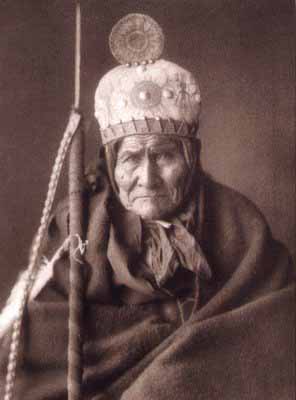
The primitive Apache was a true nomad, a wandering child of Nature, whose birthright was a craving for the warpath with courage and endurance probably exceeded by no other people and with cunning beyond reckoning. Although his character is a strong mixture of courage and ferocity, the Apache is gentle and affectionate toward those with his own flesh and blood, particularly his children.
The Apache people (including the Navajo) came from the Far North to settle the Plains and Southwest around A.D. 850. They settled in three desert regions, the Great Basin, the Sonoran, and the Chihuachuan.
They were always known as 'wild" Indians, and indeed their early warfare with all neighboring tribes as well as their recent persistent hostility toward our Government, which precipitated a "war of extermination," bear out the appropriateness of the designation.
The first intruders were the Spanish, who penetrated Apache territory in the late 1500s. The Spanish drive northward disrupted ancient Apache trade connections with neighboring tribes.
When New Mexico became a Spanish colony in 1598, hostilities increased between Spaniards and Apaches. An influx of Comanche into traditional Apache territory in the early 1700s forced the Lipan and other Apaches to move south of their main food source, the buffalo. These displaced Apaches began raiding for food.
Apache raids on settlers accompanied the American westward movement and the United States acquisition of New Mexico in 1848. The Native Americans and the United States military authorities engaged in fierce wars until all Apache tribes were eventually placed on reservations.
Most of the tribes were subdued by 1868, except for the Chiricahua, who continued their attacks until 1872, when their chief, Cochise, signed a treaty with the U.S. government and moved with his band to an Apache reservation in Arizona. The last band of Apache raiders, led by the Chief Geronimo, was hunted down in 1886 and was confined in Florida, Alabama, and finally Oklahoma Territory.
Geronimo was born in what is now the state of New Mexico and according to the maps of the time was part of Mexico, but which his family considered Bedonkohe Apache land. Geronimo himself was a Chiricahua Apache. He grew up to be a respected medicine man and an accomplished warrior who fought frequently with Mexican troops. Mexican bandits massacred some of his relatives in 1858, and as a result he hated all Mexicans for the rest of his life. His Mexican adversaries gave him the nickname of "Geronimo", the Spanish version of the name "Jerome".
Geronimo fought against ever increasing numbers of both Mexican and United States troops and became famous for his daring exploits and numerous escapes from capture. His forces became the last major force of independent Indian warriors who refused to acknowledge the United States Government in the American West. This came to an end on September 4, 1886, when Geronimo surrendered to United States Army General Nelson A. Miles at Skeleton Canyon, Arizona.
Chief Geronimo - Medicine Man - Shaman - June 16, 1829 - February 17, 1909

Geronimo was sent in as a prisoner to Fort Pickens, Florida. In 1894 he was moved to Fort Sill, Oklahoma. In his old age Geronimo became something of a celebrity, appearing at fairs and selling souvenirs and photographs of himself, but not allowed to return to the land of his birth. He rode in President Theodore Roosevelt's 1905 inaugural parade. He died of pneumonia at Fort Sill.
From Ellie Crystal